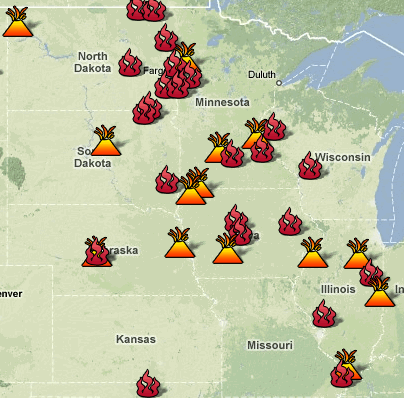Update : Reports of a welder on top of the silo, moments prior to the explosion
Just how well is the OSHA Grain Facility Standard working? Only through media accounts is it possible to ascertain the magnitude of combustible dust related fires and explosions in the grain and manufacturing sectors. Possibly someday an anonymous incident reporting system can be implemented by all stakeholders where the probability and severity of incidents can be understood in the development of process safety information for a thorough process hazard analysis.
The dust explosion at Arizona Grain brings to question the hot work permit system as outlined in the OSHA Grain Facility Standard 29 CFR 1910.272 . For instance, the employer shall issue a permit for all hot work, with the following exceptions:
1910.272(f)(1)(i) -Where the employer or the employer's representative (who would otherwise authorize the permit) is present while the hot work is being performed.
1910.272(f)(1)(iii) In hot work areas authorized by the employer which are located outside of the grain handling structure.
So is it okay to conduct hot work adjacent to an explosive atmosphere when the employer's representative is present.? What is the difference if a representative is present or not? Combustible dust will explode or deflagrate either way once an ignition source is present.
Reviewing the OSHA Welding, Cutting, and Brazing Standard, 1910 Subpart Q provides a more clearer approach to lessening the probability of fire/explosion incidents. The current OSHA Grain Facility Standard needs to be reviewed in conjunction with the OSHA Welding Standard in regards to the exception previously cited, to ensure incidents are prevented and mitigated.
In the meantime NFPA 51B: Standard for Fire Prevention During Welding, Cutting, and Other Hot Work, should be required reading for all stakeholders that conduct hot work in the vicinity of combustible particulate solids that generate combustible dust. Click here to review standard
NFPA 68 Standard on Explosion Protection by Deflagration Venting, Annex E & F is an excellent resource in understanding how the overpressure characteristics are not to be ignored. In many instances the Pmax and Kst (deflagration index) of combustible dusts is similar to Pmax and Kg (deflagration index) of flammable gases. This alone, is proof that there should be no confusion in developing a single combustible dust regulation for the variety of combustible dusts found throughout the manufacturing, non-manufacturing, utility, and grain sectors.
Resources:
Video CBS Channel 5 News
Series of Explosions
Prior Conveyor Belt Fire
Google Map Grain Facility Explosions & Fires 2008










 RSS Feed Subscribe
RSS Feed Subscribe